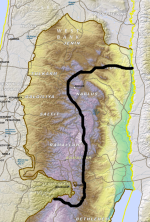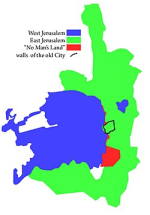So Jackson, do you think that in terms of tactical and operational proficiency, if *not* ordered to retreat prematurely, but rather trying to defend the high ground where the could, the Jordanians of 1967 had the skills and hardware and firepower it would have taken to hold on to half the West Bank through the time the Israelis had to stop for the UN and internationally sponsored ceasefire?
Which would arrive at the same date and hour as OTL?
And the Israeli offensive would have netted them in that time the classic scene of their soldiers at the foot of the Wailing Wall, and gained the miles of buffer space for the central coastal plain shown on your map? And between the satisfaction of those gains, spiritual and practical, and international pressures, the Israelis would have complied with the international pressure to ceasefire?
I imagine with Jordanians fighting more stubbornly to defend, that more artillery shells and bombs are falling back and forth in the West Bank. Even though the war is still short, only 5 or 6 days on the West Bank, greater intensity and 'grind' of combat might encourage more Palestinian flight from Israeli lines to Jordanian lines. But Palestinians would see no need to flee east of the Jordan, or those who did so for a couple nights could return back over the river immediately upon ceasefire, at least if their home or relatives' homes or viable shelter was present on the Jordanian side of the fresh ceasefire line.
Honestly, I cannot be 100% sure. But if you look at what the Israelis captured in the West Bank by the morning of June 7th when the withdrawal order was called, it looks like the image on the left. The first areas they captured a couple hours after looked like the picture in the center. Then a couple hours after that were the areas on the right. This was with no resistance. As can be observed, they followed the geography and also focused on the northern portion of the West Bank. It was only after the North was secured that the Israelis pressed south.



The Israelis had taken east Jerusalem before Nasser's order to retreat across the Jordan. The taking of the Old City, on the other hand, was a last minute decision. There was (1) a concern that fighting would wreck the place and (2) that the UN might force the Israelis to leave, which would be embarrassing for national pride. It was sort of a last minute "oh crap, the ceasefire is coming" move to go into the Old City.
While antizionists and the Zionist right have generally forgotten this, the Israelis between 1948 and 1967 basically accepted the Jordanian boundary as permanent. Jordan was seen as a nonthreatening neighbor interested in peaceable relations. What territorial ambitions Israel did have were directed south at Eastern Sinai (because Nasser's funding of Gazan and Sinai-based fedayeen and his blockading the Strait of Tiran), the Syrian-occupied portions of the mandatory Palestine (such as the east bank of the Sea of Tiberias due to water concerns, and bits of the Hula Valley). Ben Gurion also mused about grabbing up South Lebanon in 1956 so as to solidify the Christian majority in Lebanon and secure access to the Litani River's Waters, and to partitioning Jordan along the Jordan River with Iraq, but this was just spitballing that everybody else slapped down when he suggested it. The Israelis were uninterested in grabbing West Bank land before 1967, even though Ben Gurion lamented that the generals (due to politicians) hadn't able to grab more territory in 1948.
The gist of this is that the Jordanians were never really perceived as the big threat to Israel and the Israelis weren't super interested in picking fights to grab land from them. When the Six Day War started, the Israelis radio'd the Jordanians and asked them to stay out of it. When the Jordanians kept shooting at them, they radio'd again asking the same thing and promising not to attack. Hussein's response was "the die was cast" and it was too late to stop. There were back and forth Israeli and fedayeen raids into the West Bank before 1967, but the desire for quiet isn't the same as the desire for conquest. If the Israelis reach the canal on schedule like OTL, my guess is the ceasefire line in the West Bank would be wherever the two sides are and the Israelis won't be pushing for much beyond that. So long as Jordan is a stable polity, the Israelis aren't going to be interested in starting trouble there.
I suppose more Palestinians would flee from the cities like Qalqilya, Jenin, Nablus, Ramallas, Tulkarm, Bethlehem, etc. than OTL due to the grind.
Benny Morris estimates 200,000 to 250,000 the West Bank after 1967, but only 70,000 left during the fighting - most of which from the Jericho areas (ergo, right by the border). About half of those who left were people who were refugees from 1948, suggesting, they didn't have as many roots which could keep them around. The Israelis on July 2 announced that those who left in June could come back so long as they did so by August 10 (later extended to September 13) but only 120,000 applied and only 14,000 were allowed back in by the September deadline, with 3000 allowed in after in so called "special cases." Villages that were destroyed tended to be the ones that got caught in the first couple of days of fighting (Latrun, southwest of Jerusalem, and Qalqilya) and Dayan apparently said he could motivate 300,000 people to get out of the way - but in Latrun at least these people were ordered to go to Ramallah. Israeli soldiers destroyed homes in these areas without authorization, but Israeli authorities ordered them rebuilt after the war. So it seems the Israelis were mainly interested in ordering civilians to get out of the way during the fighting.
Morris doesn't explain why people weren't allowed to return, but did mention that Jordan was probably encouraging people to apply to return to Israel in order to relieve a burden. My guess is the Israelis expected their land for peace offers after the Six Day War to be accepted, and after the Khartoum Resolution (the "three nos" of September 1967), the kicking off of the War of Attrition in July 1967, and the PLO's beginning to take off as a force in the War of Attrition - the Israelis changed their minds about relieving Jordan of the cost of taking care of refugees. Immediate Israeli radio calls in the Latrun areas for example told villagers who left for Ramallah that they could come back after, but Rabin rescinded the order and Dayan later determined that the hilltop was too strategically important.
Anyways, my guess is more people might flee from the combat zone (Ramallah, Jenin, Tulkarm, and Tubas), fewer people would flee other areas (like the Jericho area/Jordan Valley), perhaps more people would voluntarily opt to just go to the Jordanian side of the line because it's closer, and more people would be able to accept the Israeli return offer before the Israelis change their mind because it's easier to walk back from one part of the West Bank to another than to swim across the Jordan.
Much of the radicalism that emerged from concentrated camps on the East Bank may still exist TTL, but my guess is that a lot more of it would be concentrated in West Bank Jordanian cities.
As a separate matter, Bethlehem, Nablus, Hebron, and especially Jericho would be bigger cities here.
Also spitballing - of the 1.2 to 1.4 million estimate from my OP, I guess it might make sense to revise that figure down a bit. Maybe 1 to 1.2 million is more likely.








